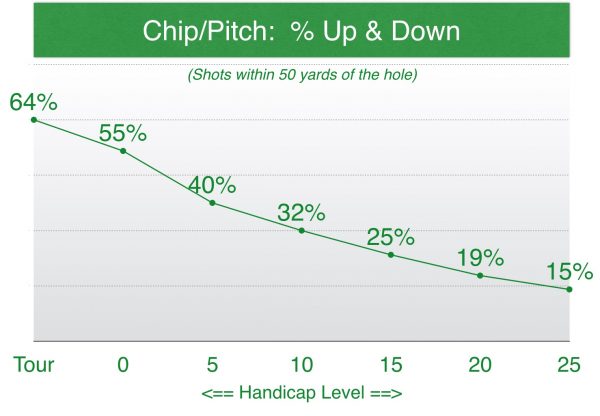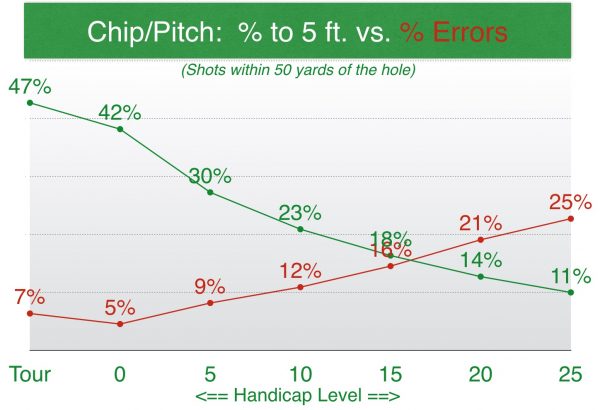Opinion & Analysis
How often should you actually get “Up-and-Down” based on your handicap?

‘Up and Downs’ have long been the accepted measure of skill in the short game. The chart below shows average performance in this area for the PGA Tour and an array of handicap levels. How do you fit in?

A few points of definition: The above refers to short game shots around the green, other than from the sand. [Stay tuned: sand shots will be my next article.] I consider the short game to be all shots from within 50 yards of the hole. This distance was a topic of debate 30 years ago when I was developing my golf analysis program. I was fortunate to be working with Golf Digest Golf Schools and some of the top instructors were good enough to embrace the better form of game analysis that I was creating. In particular, I owe a great deal to Chuck Cook, Jack Lumpkin and Hank Johnson. Their help and encouragement in my early stages gave me a much needed boost of momentum. Little did we know that what I then called “Strokes Lost and Saved” would ultimately become the accepted standard of analysis on the PGA Tour — now know as “Strokes Gained.” Anyway, we agreed that 50 yards was the right distance range for the short game for two reasons:
- It represented the short game for virtually every handicap level, men and women.
- It was a short enough distance that it didn’t need to be sliced even further.
That said, I do NOT believe that “Up and Downs” are an appropriate or accurate measure of short game skill for two reasons:
- It represents the combination of two skills: Short Game and Putting.
- It ignores the ERRORS or shots that actually miss the green.
In my 30+ years of studying performance at all skill levels, I have found that it is the FREQUENCY and SEVERITY of bad shots (errors) that do more to influence a player’s scoring level than do all the good shots. Accordingly, I built the ability to capture data on the common errors in the game into ShotByShot.com.
The true measure of a player’s short game skill is their Strokes Gained in that facet. BUT, that is simply a number — a positive number is good and a negative number, not so much. But how then to best display the skill that is associated with the Strokes Gained number? I believe the combination of three stats to be the correct way to display short game skill:
- Average putting distance, when the green is successfully hit.
- Percent shots hit to within 5 feet of the hole
- Percent errors, or shots that miss the putting surface.
Where does your game fall in these two important categories?

Note, that the two lines cross at about a 16 handicap. That is actually a better than average golfer yet for every Chip/Pitch shot that they successfully get to within 5 feet of the hole, they are also chunking or sculling one and missing the green altogether. Work to dramatically reduce the errors and that 16 will drop to 12 or 13?
You might ask: How can the PGA Tour make more errors than the scratch golfer? Good question! I have two explanations:
- They really are that good! Regardless of the relative difficulty of the shot, Tour players will go for it. They have the confidence that when they miss they will get the next up and down. At the same time, the amateur that has reached the lofty level of Scratch has generally done so thru rigorous consistency and the avoidance of errors. At the low handicap levels, a bogey can be acceptable but a mistake that results in a double is NOT.
- The tour Shotlink data considers the fringe of the green to be a miss whereas I recommend that players count the fringe as a green hit and a putting opportunity. Your long game has been efficient enough to get there and should be rewarded with the GIR. At the same time, to count the shot from the fringe as a short game shot will unfairly reward your short game skill for what was actually a putt.
That reminds me again of my very early days when Chuck Cook said to me: “Pete, Tour players don’t make errors in the short game!” See Chuck, I was right, they do! For a Complete Strokes Gained Analysis of your game, log on to: ShotByShot.com.
Related
- LIKE339
- LEGIT31
- WOW14
- LOL9
- IDHT5
- FLOP4
- OB3
- SHANK19
19th Hole
Vincenzi’s 2024 Zurich Classic of New Orleans betting preview

The PGA TOUR heads to New Orleans to play the 2023 Zurich Classic of New Orleans. In a welcome change from the usual stroke play, the Zurich Classic is a team event. On Thursday and Saturday, the teams play best ball, and on Friday and Sunday the teams play alternate shot.
TPC Louisiana is a par 72 that measures 7,425 yards. The course features some short par 4s and plenty of water and bunkers, which makes for a lot of exciting risk/reward scenarios for competitors. Pete Dye designed the course in 2004 specifically for the Zurich Classic, although the event didn’t make its debut until 2007 because of Hurricane Katrina.
Coming off of the Masters and a signature event in consecutive weeks, the field this week is a step down, and understandably so. Many of the world’s top players will be using this time to rest after a busy stretch.
However, there are some interesting teams this season with some stars making surprise appearances in the team event. Some notable teams include Patrick Cantlay and Xander Schauffele, Rory McIlroy and Shane Lowry, Collin Morikawa and Kurt Kitayama, Will Zalatoris and Sahith Theegala as well as a few Canadian teams, Nick Taylor and Adam Hadwin and Taylor Pendrith and Corey Conners.
Past Winners at TPC Louisiana
- 2023: Riley/Hardy (-30)
- 2022: Cantlay/Schauffele (-29)
- 2021: Leishman/Smith (-20)
- 2019: Palmer/Rahm (-26)
- 2018: Horschel/Piercy (-22)
- 2017: Blixt/Smith (-27)
2024 Zurich Classic of New Orleans Picks
Tom Hoge/Maverick McNealy +2500 (DraftKings)
Tom Hoge is coming off of a solid T18 finish at the RBC Heritage and finished T13 at last year’s Zurich Classic alongside Harris English.
This season, Hoge is having one of his best years on Tour in terms of Strokes Gained: Approach. In his last 24 rounds, the only player to top him on the category is Scottie Scheffler. Hoge has been solid on Pete Dye designs, ranking 28th in the field over his past 36 rounds.
McNealy is also having a solid season. He’s finished T6 at the Waste Management Phoenix Open and T9 at the PLAYERS Championship. He recently started working with world renowned swing coach, Butch Harmon, and its seemingly paid dividends in 2024.
Keith Mitchell/Joel Dahmen +4000 (DraftKings)
Keith Mitchell is having a fantastic season, finishing in the top-20 of five of his past seven starts on Tour. Most recently, Mitchell finished T14 at the Valero Texas Open and gained a whopping 6.0 strokes off the tee. He finished 6th at last year’s Zurich Classic.
Joel Dahmen is having a resurgent year and has been dialed in with his irons. He also has a T11 finish at the PLAYERS Championship at TPC Sawgrass which is another Pete Dye track. With Mitchell’s length and Dahmen’s ability to put it close with his short irons, the Mitchell/Dahmen combination will be dangerous this week.
Taylor Moore/Matt NeSmith +6500 (DraftKings)
Taylor Moore has quickly developed into one of the more consistent players on Tour. He’s finished in the top-20 in three of his past four starts, including a very impressive showing at The Masters, finishing T20. He’s also finished T4 at this event in consecutive seasons alongside Matt NeSmith.
NeSmith isn’t having a great 2024, but has seemed to elevate his game in this format. He finished T26 at Pete Dye’s TPC Sawgrass, which gives the 30-year-old something to build off of. NeSmith is also a great putter on Bermudagrass, which could help elevate Moore’s ball striking prowess.
- LIKE7
- LEGIT3
- WOW1
- LOL1
- IDHT0
- FLOP3
- OB1
- SHANK1
19th Hole
Vincenzi’s 2024 LIV Adelaide betting preview: Cam Smith ready for big week down under

After having four of the top twelve players on the leaderboard at The Masters, LIV Golf is set for their fifth event of the season: LIV Adelaide.
For both LIV fans and golf fans in Australia, LIV Adelaide is one of the most anticipated events of the year. With 35,000 people expected to attend each day of the tournament, the Grange Golf Club will be crawling with fans who are passionate about the sport of golf. The 12th hole, better known as “the watering hole”, is sure to have the rowdiest of the fans cheering after a long day of drinking some Leishman Lager.
The Grange Golf Club is a par-72 that measures 6,946 yards. The course features minimal resistance, as golfers went extremely low last season. In 2023, Talor Gooch shot consecutive rounds of 62 on Thursday and Friday, giving himself a gigantic cushion heading into championship Sunday. Things got tight for a while, but in the end, the Oklahoma State product was able to hold off The Crushers’ Anirban Lahiri for a three-shot victory.
The Four Aces won the team competition with the Range Goats finishing second.
*All Images Courtesy of LIV Golf*
Past Winners at LIV Adelaide
- 2023: Talor Gooch (-19)
Stat Leaders Through LIV Miami
Green in Regulation
- Richard Bland
- Jon Rahm
- Paul Casey
Fairways Hit
- Abraham Ancer
- Graeme McDowell
- Henrik Stenson
Driving Distance
- Bryson DeChambeau
- Joaquin Niemann
- Dean Burmester
Putting
- Cameron Smith
- Louis Oosthuizen
- Matt Jones
2024 LIV Adelaide Picks
Cameron Smith +1400 (DraftKings)
When I pulled up the odds for LIV Adelaide, I was more than a little surprised to see multiple golfers listed ahead of Cameron Smith on the betting board. A few starts ago, Cam finished runner-up at LIV Hong Kong, which is a golf course that absolutely suits his eye. Augusta National in another course that Smith could roll out of bed and finish in the top-ten at, and he did so two weeks ago at The Masters, finishing T6.
At Augusta, he gained strokes on the field on approach, off the tee (slightly), and of course, around the green and putting. Smith able to get in the mix at a major championship despite coming into the week feeling under the weather tells me that his game is once again rounding into form.
The Grange Golf Club is another course that undoubtedly suits the Australian. Smith is obviously incredibly comfortable playing in front of the Aussie faithful and has won three Australian PGA Championship’s. The course is very short and will allow Smith to play conservative off the tee, mitigating his most glaring weakness. With birdies available all over the golf course, there’s a chance the event turns into a putting contest, and there’s no one on the planet I’d rather have in one of those than Cam Smith.

Louis Oosthuizen +2200 (DraftKings)
Louis Oosthuizen has simply been one of the best players on LIV in the 2024 seas0n. The South African has finished in the top-10 on the LIV leaderboard in three of his five starts, with his best coming in Jeddah, where he finished T2. Perhaps more impressively, Oosthuizen finished T7 at LIV Miami, which took place at Doral’s “Blue Monster”, an absolutely massive golf course. Given that Louis is on the shorter side in terms of distance off the tee, his ability to play well in Miami shows how dialed he is with the irons this season.
In addition to the LIV finishes, Oosthuizen won back-to-back starts on the DP World Tour in December at the Alfred Dunhill Championship and the Mauritus Open. He also finished runner-up at the end of February in the International Series Oman. The 41-year-old has been one of the most consistent performers of 2024, regardless of tour.
For the season, Louis ranks 4th on LIV in birdies made, T9 in fairways hit and first in putting. He ranks 32nd in driving distance, but that won’t be an issue at this short course. Last season, he finished T11 at the event, but was in decent position going into the final round but fell back after shooting 70 while the rest of the field went low. This season, Oosthuizen comes into the event in peak form, and the course should be a perfect fit for his smooth swing and hot putter this week.

- LIKE12
- LEGIT3
- WOW0
- LOL1
- IDHT0
- FLOP1
- OB1
- SHANK1
Opinion & Analysis
The Wedge Guy: What really makes a wedge work? Part 1

Of all the clubs in our bags, wedges are almost always the simplest in construction and, therefore, the easiest to analyze what might make one work differently from another if you know what to look for.
Wedges are a lot less mysterious than drivers, of course, as the major brands are working with a lot of “pixie dust” inside these modern marvels. That’s carrying over more to irons now, with so many new models featuring internal multi-material technologies, and almost all of them having a “badge” or insert in the back to allow more complex graphics while hiding the actual distribution of mass.
But when it comes to wedges, most on the market today are still single pieces of molded steel, either cast or forged into that shape. So, if you look closely at where the mass is distributed, it’s pretty clear how that wedge is going to perform.
To start, because of their wider soles, the majority of the mass of almost any wedge is along the bottom third of the clubhead. So, the best wedge shots are always those hit between the 2nd and 5th grooves so that more mass is directly behind that impact. Elite tour professionals practice incessantly to learn to do that consistently, wearing out a spot about the size of a penny right there. If impact moves higher than that, the face is dramatically thinner, so smash factor is compromised significantly, which reduces the overall distance the ball will fly.
Every one of us, tour players included, knows that maddening shot that we feel a bit high on the face and it doesn’t go anywhere, it’s not your fault.
If your wedges show a wear pattern the size of a silver dollar, and centered above the 3rd or 4th groove, you are not getting anywhere near the same performance from shot to shot. Robot testing proves impact even two to three grooves higher in the face can cause distance loss of up to 35 to 55 feet with modern ‘tour design’ wedges.
In addition, as impact moves above the center of mass, the golf club principle of gear effect causes the ball to fly higher with less spin. Think of modern drivers for a minute. The “holy grail” of driving is high launch and low spin, and the driver engineers are pulling out all stops to get the mass as low in the clubhead as possible to optimize this combination.
Where is all the mass in your wedges? Low. So, disregarding the higher lofts, wedges “want” to launch the ball high with low spin – exactly the opposite of what good wedge play requires penetrating ball flight with high spin.
While almost all major brand wedges have begun putting a tiny bit more thickness in the top portion of the clubhead, conventional and modern ‘tour design’ wedges perform pretty much like they always have. Elite players learn to hit those crisp, spinny penetrating wedge shots by spending lots of practice time learning to consistently make contact low in the face.
So, what about grooves and face texture?
Grooves on any club can only do so much, and no one has any material advantage here. The USGA tightly defines what we manufacturers can do with grooves and face texture, and modern manufacturing techniques allow all of us to push those limits ever closer. And we all do. End of story.
Then there’s the topic of bounce and grinds, the most complex and confusing part of the wedge formula. Many top brands offer a complex array of sole configurations, all of them admittedly specialized to a particular kind of lie or turf conditions, and/or a particular divot pattern.
But if you don’t play the same turf all the time, and make the same size divot on every swing, how would you ever figure this out?
The only way is to take any wedge you are considering and play it a few rounds, hitting all the shots you face and observing the results. There’s simply no other way.
So, hopefully this will inspire a lively conversation in our comments section, and I’ll chime in to answer any questions you might have.
And next week, I’ll dive into the rest of the wedge formula. Yes, shafts, grips and specifications are essential, too.
- LIKE32
- LEGIT7
- WOW1
- LOL1
- IDHT2
- FLOP3
- OB1
- SHANK3
-

 19th Hole2 weeks ago
19th Hole2 weeks agoDave Portnoy places monstrous outright bet for the 2024 Masters
-

 19th Hole2 weeks ago
19th Hole2 weeks agoTiger Woods arrives at 2024 Masters equipped with a putter that may surprise you
-

 19th Hole2 days ago
19th Hole2 days ago‘Absolutely crazy’ – Major champ lays into Patrick Cantlay over his decision on final hole of RBC Heritage
-

 19th Hole2 days ago
19th Hole2 days agoJustin Thomas on the equipment choice of Scottie Scheffler that he thinks is ‘weird’
-

 19th Hole3 weeks ago
19th Hole3 weeks agoReport: Tiger Woods has ‘eliminated sex’ in preparation for the 2024 Masters
-

 19th Hole1 week ago
19th Hole1 week agoTwo star names reportedly blanked Jon Rahm all week at the Masters
-

 19th Hole1 week ago
19th Hole1 week agoReport: LIV Golf identifies latest star name they hope to sign to breakaway tour
-

 19th Hole1 week ago
19th Hole1 week agoNeal Shipley presser ends in awkward fashion after reporter claims Tiger handed him note on 8th fairway























Radim Pavlicek
Jul 19, 2018 at 7:32 am
One thing which has not been said is that if you are a 90+ golfer and scratch golfer would play all your inside 50 meters shots, they won’t score those 50 plus %! That is not all about the skill. If they miss it, they miss it in a spot where easy up&down is possible.
TONEY P
Jul 19, 2018 at 5:37 am
Nice data but I think it should be 25 yards not 50. As skill level increases so does a players range of execution.
Don
Jul 19, 2018 at 10:23 am
What do you mean?
Dan Jones
Jul 18, 2018 at 10:14 pm
I believe there is a third reason that the PGA Tour players might be slightly worse than the scratch players in your data. Typically they play on much more difficult courses than your average muni or even some resort courses and private clubs, some of which are designed with higher handicap players in mind. That said, if some of the scratch players had to play on more difficult courses, they wouldn’t be scratch!
Good article with interesting data. Of course there are many variables unaccounted for which would be interesting to see, such as how different age groups perform these tasks. For instance, I worked at a country club with an elderly population and some of them could only hit the ball 190 yards, so some of the par 4’s were 3 shot holes for them, yet several (men and women both) were excellent at chipping and putting. The ladies even had a pot during ladies day for chip-ins, and it rarely went unclaimed and often had to be split.
Pete McGill
Jul 18, 2018 at 7:30 pm
The numbers pretty much reflect my game: breaking 80 is considered a good day out. Playing at a club known for its small greens, I figure I might hit 4-6 and then get up and down another 6 or so. Minimising the other holes to bogey will be the difference between a disappointing 83 or a 78.
Don
Jul 19, 2018 at 10:31 am
Good way to look at it. I’m the ‘other’ type of typical: I make 0 – 5 major tee mistakes per round, hoping they happen at red stakes v white, and my short putting varies from amazing(ly bad) to very good. On the days I’m a combination of lucky and good, a 78 is possible. On days I get the opposite combination, a 98 is possible. Have shot 93-77 on the same day and 104-79 the same week. Frustrating game this golf, and am hoping this latest run at lessons provides the elusive consistency I’ve been seeking for decades.
Bob Castelline
Jul 18, 2018 at 2:02 pm
This is interesting. I’m in that single-digit handicap range, trying to push it as close to scratch as I can. I’ve always thought that if I could hit 12 greens and get up and down 3 of the other 6, I’d be doing pretty well. This pretty well confirms it. At 58 years old, I don’t anticipate any great revelation in my swing that’s going to get me 25 more yards off the tee, but I can keep working on the short game and maybe reduce a few of those errors. Good stuff!
Benny
Jul 18, 2018 at 3:35 pm
well said!
Peter Sanders
Jul 19, 2018 at 2:51 pm
Thanks Bob, you are on the right track – best of luck!